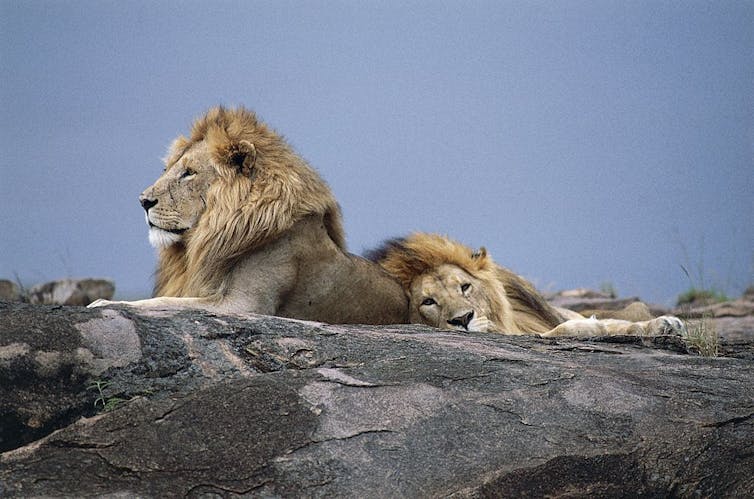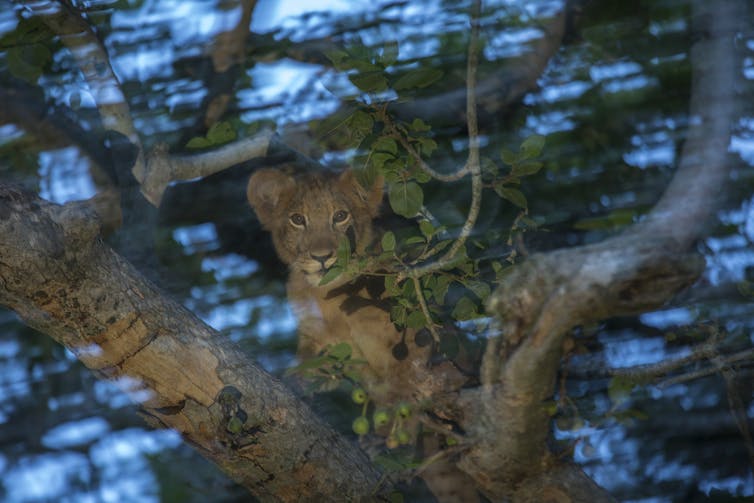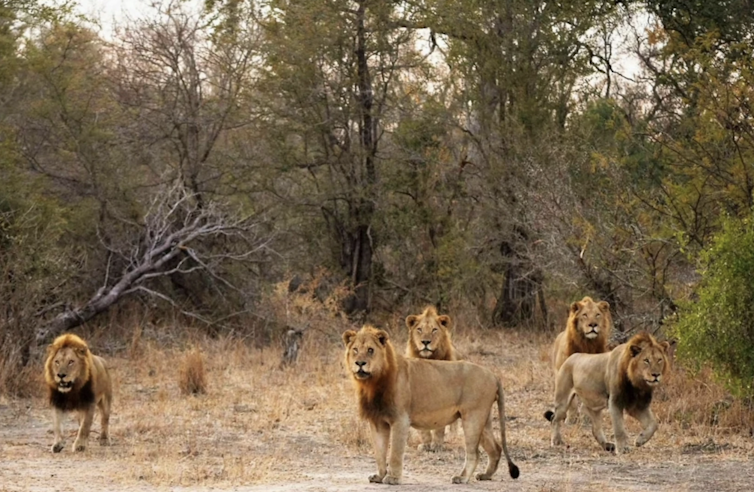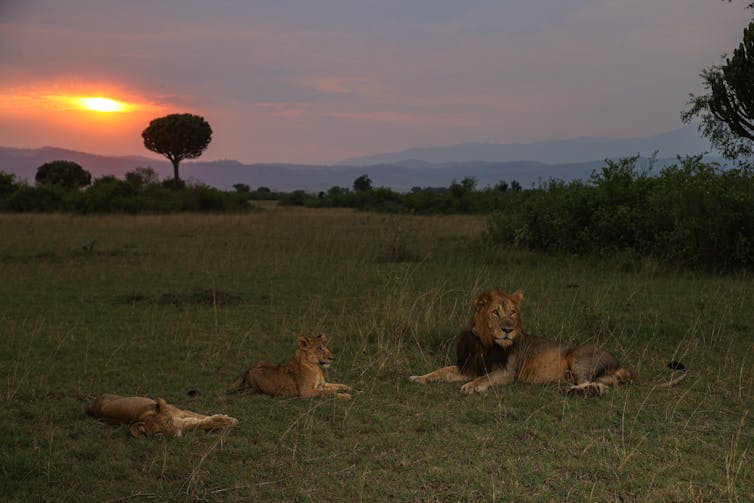
Alexander Richard Braczkowski, Griffith University; Duan Biggs, Northern Arizona University, and Peter Lindsey, Griffith University
The death of a lion in Kenya’s picturesque savannas rarely tugs at people’s hearts, even in a country where wildlife tourism is a key pillar of the nation’s economy. But when one of the most tracked male lions in Kenya’s famous Masaai Mara was killed on 24 July 2023 the world took notice. Known as Jesse, he was killed during a fight with a coalition of three male lions from a rival pride, drawing attention to the brutally risky and dangerous lives of male lions.
Lions are organised in family groups known as a pride. Each pride is comprised of several related lionesses. One or more adult male lions will also be present. In the public imagination, male lions are better known by their popularised image as kings of the jungle. Their bravery, strength, and size (only tigers are larger) fits this profile.
But in reality, male lions live a life far more vulnerable. One in two male lions die in the first year of life. From the moment a male lion is born it faces a gauntlet of challenges – from snakebite and hungry hyenas to infanticide at the hands of other male lions.
If a male lion makes it out of their first year of life, and then to independence at around 3, they leave their pride for a period of nomadism. Nomads lead a dangerous existence, skirting the territories of established male coalitions. Out there on their own, few will make it to the age of 10.

At no time, it seems, is the male lion safe. We know from the evidence collected by the Kenya Wildlife Trust, resident guides, and tourists that Jesse administered and received many beatings from other male lions. We also know that Jesse, who lived to the ripe old age of 12, was eventually killed by three younger, stronger lions. Life comes full circle: killers frequently become victims themselves, of younger, brasher lions, or those in larger and thus more powerful coalitions.
We are three researchers with over 50 years of combined experience in big cat ecology, conservation, and the complexities of people and wildlife living together.
We base our commentary on the extensive information gathered by conservation organisations, independent scientists and tourism guides working in the Maasai Mara. Information on Jesse has been collected mainly through sightings data compiled by these entities over time.
Often the survival of male lions will be dictated by the size and strength of their coalitions, and the make up of the lion landscape at large. This sometimes has bearing for conservation especially when lions stray out of national parks or when male lions are hunted after leaving the safety of a protected area.
The trials of a young lion
A young male lion’s biggest threat is his exposure to other male lions that aren’t their father or uncle. A host of studies from the Serengeti in Tanzania to Zimbabwe show that the most significant single cause of lion mortality in the first year of a lion’s life is attributed to other male lions that kill them during infanticide.
This involves incoming males seeking out and killing the cubs of other males or driving young males away, and attempting to take over prides. Killing cubs accelerates the onset of oestrus in pride females and so is likely to increase the reproductive success of incoming males.
Most lions that get pushed out of their pride when very young don’t survive.
Cubs that survive to independence – around 3 years of age – must leave their pride for a period of nomadism. During this time, they join up with cousins, brothers, and sometimes unrelated males of similar age to form what biologists term ‘coalitions’. The power of coalitions increases dramatically with the size of the group. This power can be defined by the number of different prides these coalitions are likely to rule, the number of offspring they will sire, and the number of times they will successfully be able to defend their prides from violent incursions from neighbouring male lions and their coalitions.
The tradeoff of larger coalitions is a watering down of a male lion’s reproductive opportunities.
Examples of such powerful coalitions include the six-strong
.Contrastingly, Jesse had only one coalition mate, a lion known as Frank. The two were strong enough to kick out the duo of Dere and Barrikoi from the Offbeat pride in May 2014. After his coalition mate Frank disappeared, Jesse left the Offbeat Pride and led a largely nomadic lifestyle except when he unsuccessfully tried to take over the Rakero pride and even fought with his own son Jesse 2.

Three laws of the wild
Mate, protect, fight. These are the three tenets most male animals live and die by in the animal kingdom and this could not be truer for male lions. When male lions are in the prime of their lives somewhere between 5 and 9 years of age they will attempt to have as many cubs as they can. And they will do their best to protect and guard over as many prides as possible.
But there is a fine line between holding tenure over many different prides, and successfully being able to defend them and their young. When fights do breakout between male lions they are usually over territorial and breeding rights.
At times they are mere squabbles between coalition mates. At other times, the battles are big enough to cause rifts and splits within coalitions. But in most cases fights are between rival coalitions.
including posturing, roaring and growling, swatting, and biting, and even urination and territorial demarcation.
For conservation: look to the lionesses
When it comes to the conservation of the lion species it is important to look to the lionesses. They are the sentinels of a populations health, specifically the number of animals in a group, and more importantly the ratio of lionesses to lions. Healthy populations can expect ratios of roughly 2 females for every male, but when under pressure due to poaching, killings by cattle farmers and a loss of prey these ratios invert towards males.
The story of Jesse highlights how, in spite of their status as king of the beasts, lions are vulnerable. While in this instance, the cause of death was another lion, much more commonly, lions die at the hands of humans. This can be through being shot or poisoned to protect livestock, being poached for their body parts or being caught as by-catch in traps and snares set for other animals by bushmeat poachers.
On the plus side, the fascinating pride dynamics and trials and tribulations of individual lions can help capture the public’s imagination and foster a love for the species and other wildlife. Although human pressures are high, Kenya retains a large lion population and a suite of iconic wildlife areas. These assets are a great source of pride for many Kenyans, and rightly so.![]()
Alexander Richard Braczkowski, Research Fellow at the Centre for Planetary Health and Resilient Conservation Group, Griffith University; Duan Biggs, Professor and Chair, Southwestern Environmental Science and Policy, Northern Arizona University, and Peter Lindsey, Research associate, Griffith University
This article is republished from The Conversation under a Creative Commons license. Read the original article.

